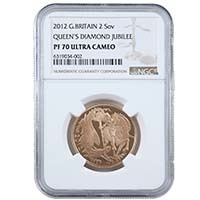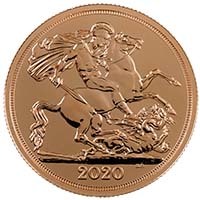.jpg)
What's better than a Sovereign? A Double Sovereign! These UK gold coins are much rarer than their smaller cousins but their story stretches back just as far. This article is a complete guide to the history of the Double Sovereign, its specifications and value as well as the number of these coins issued in each year.
Tudor Hammered Sovereigns
The first Double Sovereigns were double-weight piedfort versions of the 15.55 gram gold Sovereigns introduced during the reign of King Henry VII.
These extra-heavy hammered gold Sovereigns were probably intended as presentation pieces and were rich in the symbols of the nascent Tudor dynasty. They show a full length enthroned portrait of the king to the obverse with a portcullis beneath his feet, taken from the heraldic badge of the House of Beaufort through whom Henry staked his claim to the crown. The reverse featured a Tudor rose, combining the floral emblems of the Houses of Lancaster and York. These Double Sovereigns are supremely rare with only three examples known.

Illustration of a hammered gold Sovereign, struck in the reign of Henry VII. Double or piedfort Sovereigns from the Tudor period are among the rarest British gold coins. Credit: Look and Learn.
Sovereigns and Half Sovereigns were minted through the sixteenth century and into the early years of King James I's reign. The Double Sovereign would not be struck again until the name was revived for a new gold denomination in the early nineteenth century.
The First Modern Double Sovereigns
Like those remarkable piedfort Tudor coins, the earliest modern Double Sovereigns were not intended for circulation. They were minted three years after the introduction of the British Sovereign in 1817. These new Sovereigns had the same face value as their hammered predecessors - £1 sterling - but were composed of a more modest 7.98 grams of 22 carat gold.
The first milled Double Sovereign was issued as a pattern in 1820. They featured a laureate head of George III to the obverse and Benedetto Pistrucci's famed engraving of England's patron saint - St George - to the reverse. Supposedly, these scarce Double Sovereigns and the even rarer 1820 Five Sovereign were struck on the night of George's death as a tribute to the late king.
.jpg)
Portrait of George III from around 1800 by William Beechey. The first modern Double Sovereigns were struck at the end of George's reign, reportedly on 29 January 1820: the very night of his death.
The denomination entered circulation in 1823 with Jean Baptiste Merlen's portrait of George IV on the obverse and Pistrucci's St George to the reverse. A very small number of proofs were issued in 1824, 1825 and 1826 with a crowned shield of arms reverse. A similar design was used on the single proof Double Sovereign issued in William IV's coronation year (1831).
These Georgian coins established a specification for the Double Sovereign that is followed to this day.
Double Sovereigns are composed of 15.98 grams of 22 carat gold (that's 0.4708 troy ounces of pure gold) and have a diameter of 28.40 millimeters.
Victorian Double Sovereigns
While a pattern Quintuple Sovereign was struck in 1839 (colloquially called Una and the Lion), the Double Sovereign would not be seen again until 1887, the year of Queen Victoria's Golden Jubilee.
You'll find proof 1887 Double Sovereigns in Golden Jubilee proof sets but these coins were struck for circulation too. Both versions show the controversial Jubilee Head portrait, first seen in this year, and feature Pistrucci's St George to the reverse. These Double Sovereigns were struck in London but also at the Sydney mint in very small numbers.
When a new portrait - the Old Head or Widowed Head - replaced the jubilee effigy in 1893 a further issue of Double Sovereigns was made, again in proof and for circulation.
It's unlikely that many of these Victorian Double Sovereigns were used in transactions as they are often found in excellent grade. Perhaps they were kept as royal souvenirs.
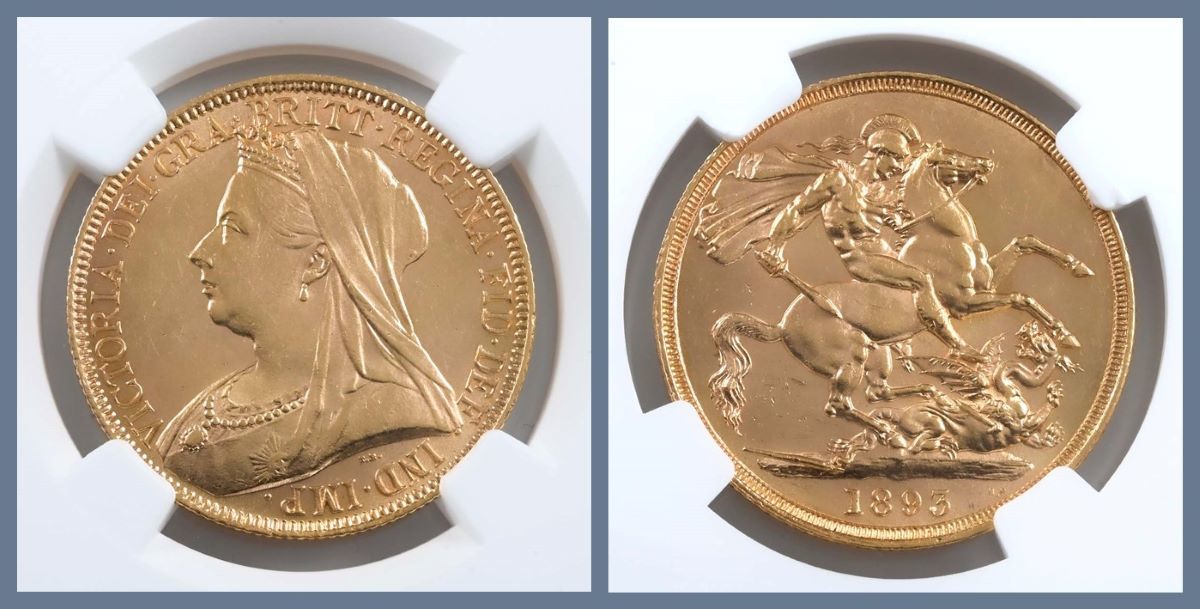
1893 Old Head Double Sovereign, graded MS 61 by NGC. The Double Sovereign was revived late in Queen Victoria's reign.
The Modern Double Sovereign
Another issue of Double Sovereigns was made in 1902 - the year of King Edward VII's coronation - bearing a royal portrait by George William de Saulles. For the next half century, these coins were only seen as part of coronation proof sets, appearing again in 1911 and 1937. A Double Sovereign was struck in 1953 for Elizabeth II but just for completeness: these proof coins remain in museum collections.
While the Double Sovereign made only sporadic appearances, the 'full' Sovereign remained a regular annual issue until the start of the First World War. They continued to be a popular trade coin, particularly in the Middle East, long after they fell out of circulation in Britain, leading to a proliferation of counterfeits. In an effort to counter this and capitalise on the investment and collectors market, new Sovereigns began to be issued again in 1974, the denomination having survived decimalisation.
Proof Double Sovereigns rejoined The Royal Mint's roster of collectors coinage in 1980. At first they were only sporadically available but were offered in individual presentation packaging. For the last 25 years, proof Double Sovereigns have only been available in three-coin, four-coin and five-coin Sovereign sets. It's only in the last couple of years that bullion or 'uncirculated' Sovereigns have been offered either loose or in blister packs.
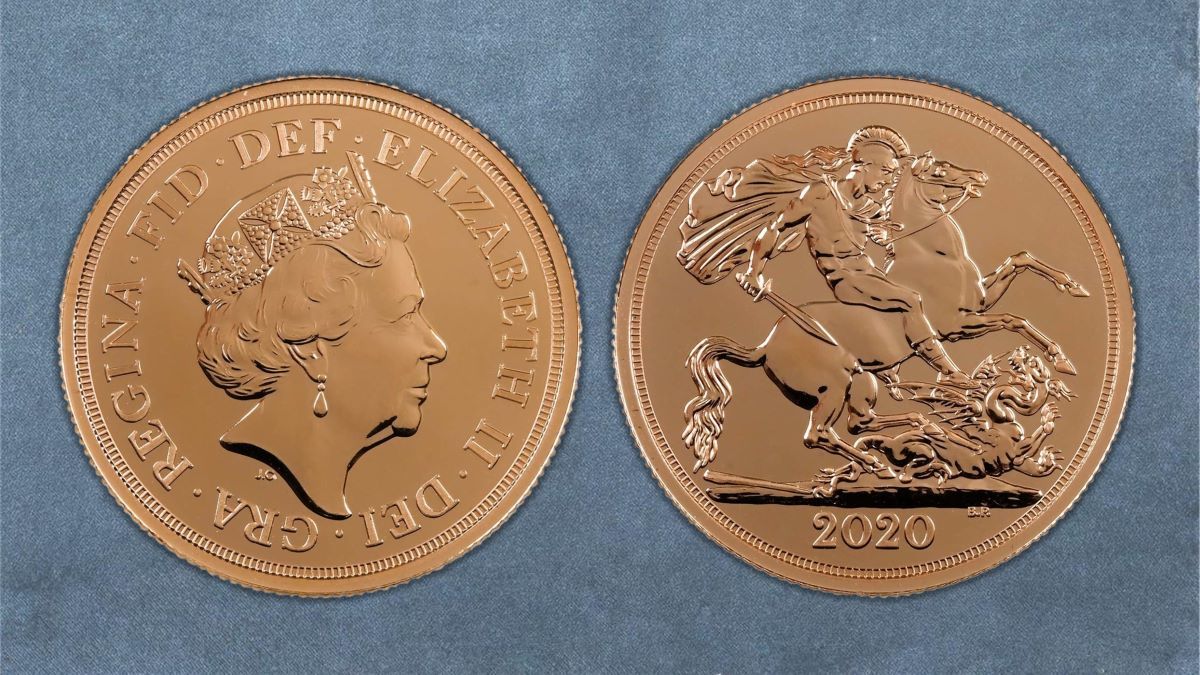
2020 uncirculated Double Sovereign. Elizabeth II Double Sovereigns have generally only been available in proof sets though The Royal Mint has recently started offering individual bullion coins, aimed at investors.
These coins have generally featured the historic image of Saint George to the reverse though one-off commemorative designs were carried over to the full Sovereign family in 1989, 2002, 2005, 2012, 2017 and 2022.
Scroll down for a full list of Elizabeth II Double Sovereigns with mintages.
UK Circulating Two Pound Coins
Double Sovereigns are technically a Two Pound coin though they're worth much more than than thanks to their gold content and collectibility. Their legal tender status is important as it lends Double Sovereigns a Capital Gains Tax exemption that appeals to serious investors.
In 1986 a new £2 coin was struck by The Royal Mint, first as a commemorative coin, available in cupronickel as well as collectible precious metal editions. These were replaced by a bimetallic general circulation coin in 1998. At first these coins featured a technology-inspired reverse, designed by Bruce Rushin, but since 2015 Anthony Dufort's depiction Britannia has been used. A wide range of variant designs have also been issued to mark important events and anniversaries.
These commemorative Two Pounds have been offered in gold with the same general specification as a Double Sovereign: 15.98 grams of 22 carat gold and a 28.40 millimeter reverse. That said, they are often categorised separately to modern Double Sovereigns. Spink's guide to decimal coinage, for instance, places Double Sovereigns with Sovereigns and gold Two Pounds next to One Pounds and Fifty Pence pieces. 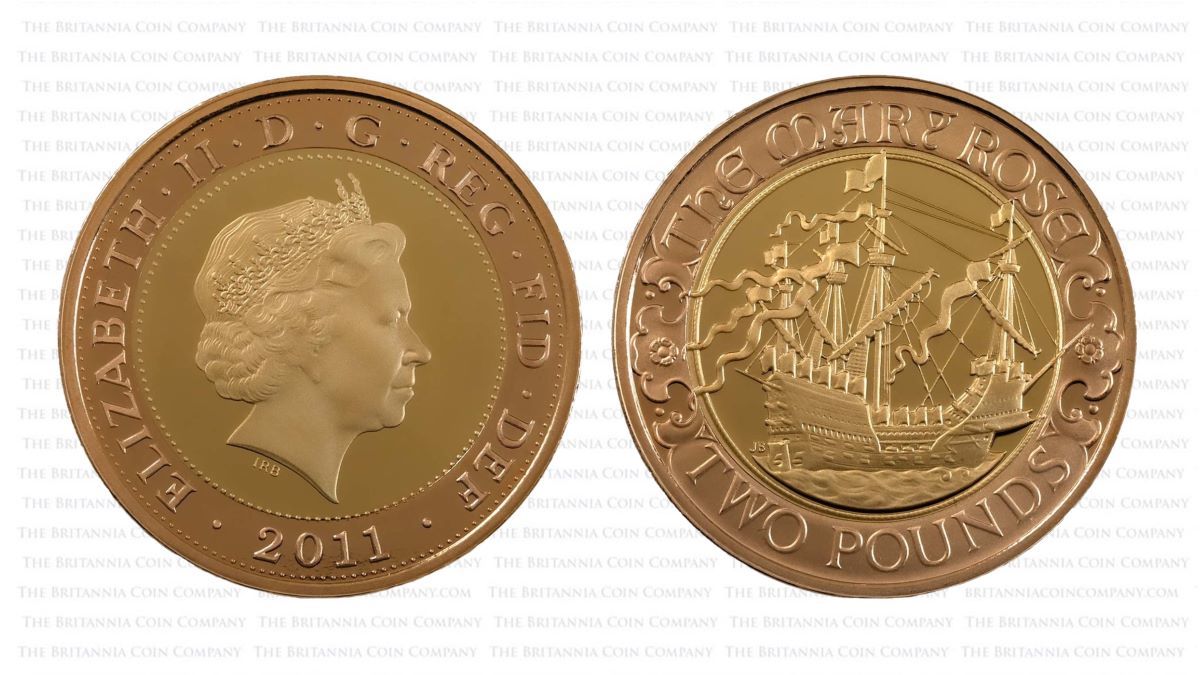
A 2011 commemorative gold proof Two Pound coin that looks back to the Tudor roots of the denomination to celebrate 500 years since the launch of the Mary Rose. The red-gold rim apes the bimetallic composition of modern circulating £2 coins.
Double Sovereign Mintage Figures
Double Sovereigns remain scarce and it can be challenging for collectors to assemble a full set. Here's the full list of Elizabeth II Double Sovereigns and their mintage figures to get you started:
| Issue | Mintage |
| 1953 Gold Proof Double Sovereign | Museums only |
| 1980 Gold Proof Double Sovereign | 10,000 |
| 1982 Gold Proof Double Sovereign | 2,500 |
| 1983 Gold Proof Double Sovereign | 12,500 |
| 1985 Gold Proof Double Sovereign | 5,849 |
| 1987 Gold Proof Double Sovereign | 1,801 |
| 1988 Gold Proof Double Sovereign | 1,551 |
| 1989 Gold Proof Double Sovereign 500th Anniversary | 2,000 |
| 1990 Gold Proof Double Sovereign | 716 |
| 1991 Gold Proof Double Sovereign | 620 |
| 1992 Gold Proof Double Sovereign | 476 |
| 1993 Gold Proof Double Sovereign | 414 |
| 1994 Gold Proof Double Sovereign Bank of England | 1,000, plus 2,500 in sets* |
| 1996 Gold Proof Double Sovereign | 742, issued in sets |
| 1998 Gold Proof Double Sovereign | 1,349, issued in sets |
| 2000 Gold Proof Double Sovereign | 2,250, issued in sets |
| 2002 Gold Proof Double Sovereign Golden Jubilee | 6,947, issued in sets |
| 2003 Gold Proof Double Sovereign | 3,787, issued in sets |
| 2004 Gold Proof Double Sovereign | Unknown, issued in sets |
| 2005 Gold Proof Double Sovereign St George | 2,958, issued in sets |
| 2006 Gold Proof Double Sovereign | 2,290, issued in sets |
| 2007 Gold Proof Double Sovereign | 2,401, issued in sets |
| 2008 Gold Proof Double Sovereign | 2,333, issued in sets |
| 2009 Gold Proof Double Sovereign | 2,416, issued in sets |
| 2010 Gold Proof Double Sovereign | 2,019, issued in sets |
| 2011 Gold Proof Double Sovereign | 2,149, issued in sets |
| 2012 Gold Proof Double Sovereign Diamond Jubilee | 1,994, issued in sets |
| 2012 Gold BU Double Sovereign Diamond Jubilee | 60, issued in sets |
| 2013 Gold Proof Double Sovereign | 1,895, issued in sets |
| 2013 Gold BU Double Sovereign | 124, issued in sets |
| 2014 Gold Proof Double Sovereign | 1,516, issued in sets |
| 2014 Gold BU Double Sovereign Prince George Birthday | 835 |
| 2015 Gold Proof Double Sovereign Ian Rank-Broadley Portrait | 1,100, issued in sets |
| 2015 Gold Proof Double Sovereign Jody Clark Portrait | 1,046, issued in sets |
| 2016 Gold Proof Double Sovereign James Butler Portrait | 925, issued in sets |
| 2017 Gold Proof Double Sovereign 200th Anniversary | 1,198, issued in sets |
| 2018 Gold Proof Double Sovereign | Unknown, issued in sets |
| 2019 Gold Proof Double Sovereign | Unknown, issued in sets |
| 2020 Gold Proof Double Sovereign | Unknown, issued in sets |
| 2020 Gold Bullion Double Sovereign | Unknown |
| 2021 Gold Proof Double Sovereign | Unknown, issued in sets |
| 2021 Gold Bullion Double Sovereign | Unknown |
| 2022 Gold Proof Double Sovereign | Unknown, issued in sets |
| 2022 Gold Bullion Double Sovereign | Unknown |
 *An interesting outlier: The Royal Mint issued a gold Two Pound coin in 1994 to mark the 300th anniversary of the Bank of England. Spink lists this coin with other Two Pounds but the leaflet included in the box calls this a Double Sovereign. Photos show a rare mule with an obverse error.
*An interesting outlier: The Royal Mint issued a gold Two Pound coin in 1994 to mark the 300th anniversary of the Bank of England. Spink lists this coin with other Two Pounds but the leaflet included in the box calls this a Double Sovereign. Photos show a rare mule with an obverse error.
How To Sell A Gold Double Sovereign
Whether you've got a single Double Sovereign or several gold coins to sell, we're happy to provide you with a no obligation quote. The Britannia Coin Company buys Sovereigns at our precious metals counter in Royal Wootton Bassett as well as operating a sale-by-mail service, meaning you can get an industry leading price for your old coins from home. Visit our Sell Your Coins page for more information or contact us for a valuation.
Frequently Asked Questions
Double Sovereigns are stuck in limited numbers and their value is impacted by their rarity. Collectors have long sought these large gold coins for their high gold content and their long history which stretched back to the time of the Tudor kings.
Double Sovereigns offer twice the amount of gold as a regular full Sovereign and all the same tax benefits (VAT and CGT exemptions). Historically, Double Sovereigns have only been struck in small numbers and are, consequently of interest to collectors.
Double Sovereigns are composed of 15.98 grams of 22 carat (916.7) gold. This means that they contain 0.4708 troy ounces of pure gold or 14.65 grams: that’s twice the amount of gold as a regular ‘full’ Sovereign and, as such, these coins have a larger diameter.
All Double Sovereigns minted since 1817 have a weight of 15.98 grams. Double Sovereigns are composed of 22 carat (916.7) gold so their pure gold weight is 14.65 grams or 0.4708 troy ounces. These specifications have been strictly adhered to for more than 200 years.
The rarest Double Sovereigns are the piedfort hammered Sovereigns struck during the reign of Henry VII. When the denomination was revived in the early nineteenth century these coins were initially struck in small numbers and rarely circulated. Georgian milled Double Sovereigns are also, consequently, very rare.
Double Sovereigns are twice the weight of a regular ‘full’ Sovereign and contain exactly twice the amount of gold. Double Sovereigns are rarer than Sovereigns as they have been issued less frequently than their smaller counterparts.
Georgian and Victorian Double Sovereigns are among the most valuable examples of these coins on the market. Since most of these nineteenth century Double Sovereigns were not issued for circulation they can often be found in high grade.
In the last twenty years, most Double Sovereign struck at The Royal Mint have been issued in proof sets. Sometimes these sets are split by sellers so it's possible to buy these gold coins on their own, either loose or professionally graded.
The Britannia Coin Company offers modern Double Sovereigns in both proof and bullion finishes. Professionally graded Double Sovereigns are a popular choice, as are our Georgian and Victorian Double Sovereigns and our new bullion Royal Mint Double Sovereigns.
You can sell your Sovereigns and Double Sovereigns from home with The Britannia Coin Company. Use our Sell Your Coins page to get a quote for your gold coins. If you're based in the South West then why not sell your Double Sovereigns in person at our Wiltshire shop?
Use our Sell Your Coins page to get a no obligation quote for your Double Sovereigns from home. The Britannia Coin Company - part of Gold-Traders UK - pays market leading prices for gold coins like Double Sovereigns and the best thing is you can get paid by post.
Modern gold Two Pound coins have the same specifications as the Double Sovereign: they are both composed of 15.98 grams of 22 carat gold and have a diameter of 28.40 millimetres. Gold Two Pounds may show a bimetallic effect where the outer ring is made of red gold.

.jpg)


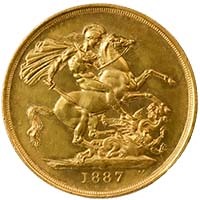

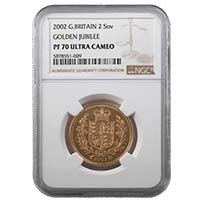
.jpg)
